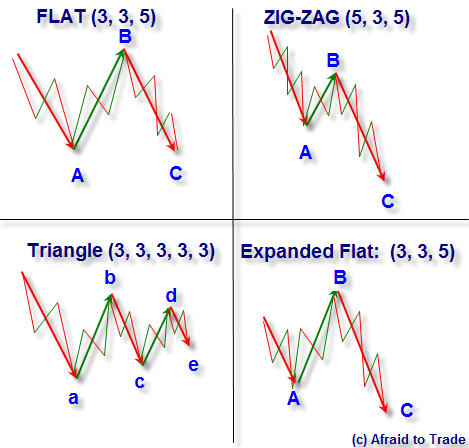Courtesy of Corey at Afraid to Trade
Elliott Wave Quick Cheat Sheets
Readers have asked me to provide a quick reference to some of the basic principles of Elliott Wave, so use these charts as a quick reference or “cheat sheet” to getting started ‘reading’ Elliott Wave analysis.
First, a complete Elliott Wave pattern has 8 waves: 5 during the “impulse” phase and 3 during the “corrective” phase.

Elliott Wave is a fractal concept, so look closely at Wave (1) and Wave (2). The entire 8-wave structure that comprises the first and second wave is exactly the same as the complete 8-wave structure that completes the whole chart, which itself might be a larger Wave 1 and Wave 2 of a higher timeframe. It is important to understand that Elliott Wave is fractal.
In an impulse (an uptrend, for simplicity), Waves 1, 3, and 5 will ’subdivide’ into their own smaller 5-wave affairs. Waves 2 and 4, which move against the larger trend, have a 3-wave structure. This is an expansion of “Charles Dow Theory” which states that uptrends (bull markets) move in three phases (accumulation, realization, distribution). Elliott only adds the natural corrective waves into these three phases. Mr. Dow also made note of fractal trends (Primary, Intermediate, Minor).
In reality, Elliott Wave principles are just additions or specifications to Charles Dow Theory.
Speaking of Corrections, here are the ‘ideal’ corrective phase types:

There are actually 13 corrective patterns which are combination of these, but for simplicity, let’s focus on these four types of corrections.
The notation in parenthesis refers to the number of smaller waves in the lettered phase (corrections always use letters). With the exception of a Triangle, Wave C will always have 5 waves. Without exception, Wave B will always have 3 waves. With the exception of a Zig-Zag (my favorite correction, which resembles a ‘bear flag’), Wave A will always have 3 waves.
I’ll create a series of posts with basic educational introductions (making them fun and interesting) to the Elliott Wave principle so stay tuned for more!
Corey Rosenbloom, CMT
Afraid to Trade.com


